Tracing Picasso's footsteps in Málaga
Though the legendary artist spent most of his life in France, Málaga in Spain, where the artist was born and learnt to paint, continued to inspire him all his life
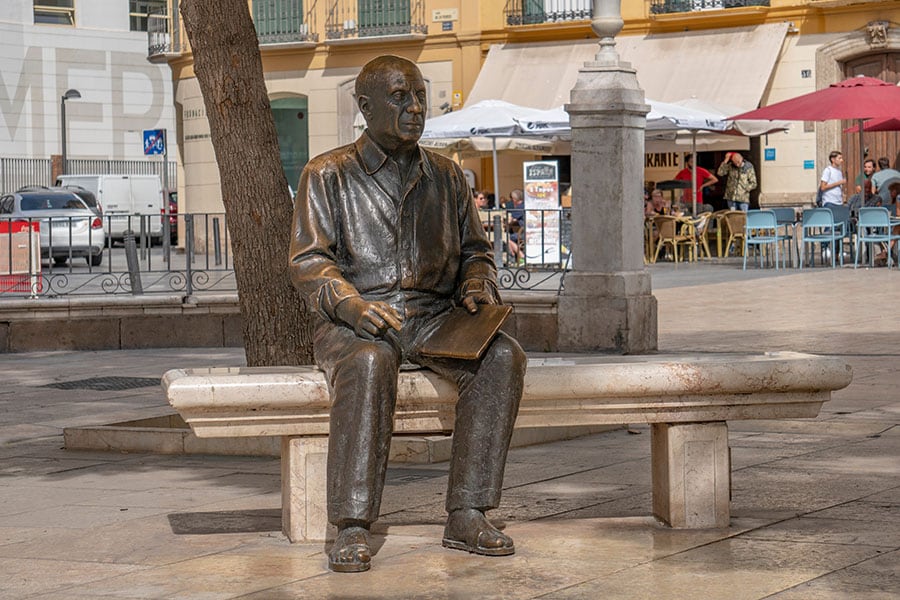 Capturing the essence of a genius, this bronze statue of Pablo Picasso in Malaga pays tribute to the city's most illustrious son, immortalizing the artist in his hometown's vibrant streets.
Image: Shutterstock
Capturing the essence of a genius, this bronze statue of Pablo Picasso in Malaga pays tribute to the city's most illustrious son, immortalizing the artist in his hometown's vibrant streets.
Image: Shutterstock
As I wandered through the sunlit streets of Plaza de la Merced in Málaga, Spain, I came upon a striking bronze statue of Pablo Picasso. Seated thoughtfully on a bench with a notebook in hand, this evocative monument beckoned me to delve into the profound legacy of the legendary artist. Interestingly, the sculptor, Francisco López Hernández, has crafted the statue slightly larger than life, adding a touch of whimsy to this homage to Málaga's most famous son.
Related stories
Picasso, born in Málaga in 1881, called Plaza de la Merced home for a decade. Back then, the area was lined with towering houses, their green windows a distinct feature. Today, the plaza bustles with umbrellaed pavement cafes, shopping avenues, and taverns, offering a glimpse into the artist's early surroundings. And though he spent much of his life in France, Picasso's Spanish identity is unmistakable in his art's motifs and inspirations, something that continued to inspire him all his life.
“Picasso began painting at the age of seven. Although he last visited Málaga in 1901 and Spain in 1934, his connection to his homeland remained profound throughout his life,” my guide Trinidad Blanco says, gesturing towards the stately building in the heart of the Plaza de la Merced in the Centro Histórico that once housed the Picasso family and now stands as the Museo Casa Natal. The museum delves into the story of Picasso's childhood and his family's life in Málaga, showcasing private collections of the artist and relics from his upbringing, including books and furniture from his father, José Ruiz y Blasco, an art professor.
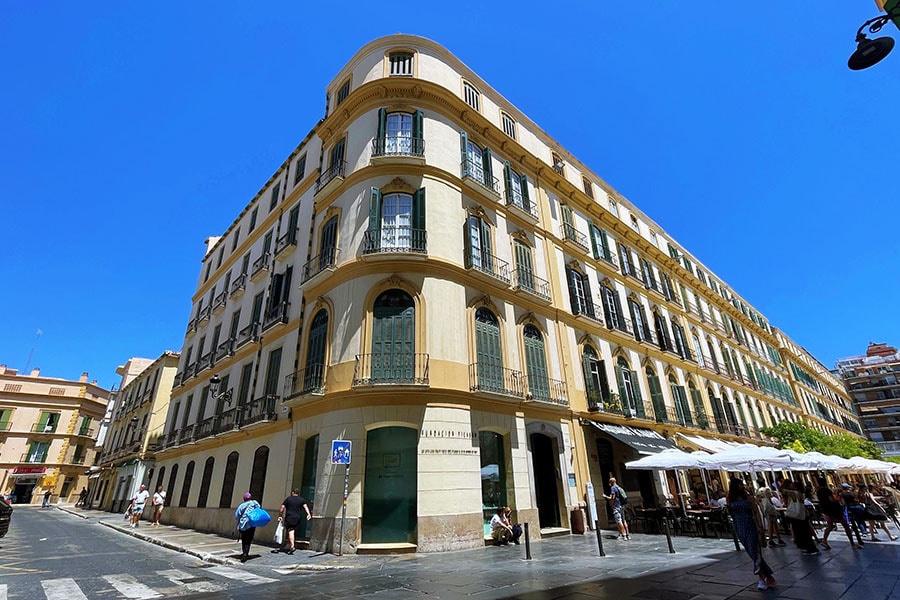 The "Casa Natal" or birthplace of the world famous artist Pablo Ruiz Picasso has been an official heritage site since 1983.
Image: Veidehi Gite
The "Casa Natal" or birthplace of the world famous artist Pablo Ruiz Picasso has been an official heritage site since 1983.
Image: Veidehi Gite
Conversely, A few streets away, the Museo Picasso, housed in the 16th-century Buenavista Palace—an exquisite blend of Andalusian architecture featuring Renaissance and Mudéjar elements—offered me a journey into Picasso's formative years through three significant exhibits. The first is about Picasso’s childhood in Málaga and the heritage of Spanish culture that provided a foundation for his art. At the age of 15, he portrayed his sister Lola with a doll. Rather than a simple portrait, the painting demonstrates Picasso’s already sophisticated range as an artist. Lola’s high-necked white dress is typical of Spanish society in the late 19th century. The Japanese doll hanging on the wall shows that Picasso was already responding to Asian art. Painted 70 years later, Maternity (1970) might seem to repudiate the artistic traditions of Picasso’s youth. Yet, the painting’s subject of a woman and a child is central in Spanish religious art. Moreover, both this painting and the bronze sculpture Child (1960) show that late in life Picasso often returned to the image of a child as a symbol of rejuvenation in life and art.
The second exhibit delves into Picasso's engagement with tradition and revolution. During the decade leading up to his groundbreaking 1907 painting Les Demoiselles d’Avignon, Picasso’s extensive explorations laid the groundwork for an unparalleled array of artistic approaches. Les Demoiselles d'Avignon (The Young Ladies of Avignon, originally titled The Brothel of Avignon) is a large oil painting featuring figures that are confrontational and unconventional, depicted with angular, disjointed body shapes that convey a menacing presence.
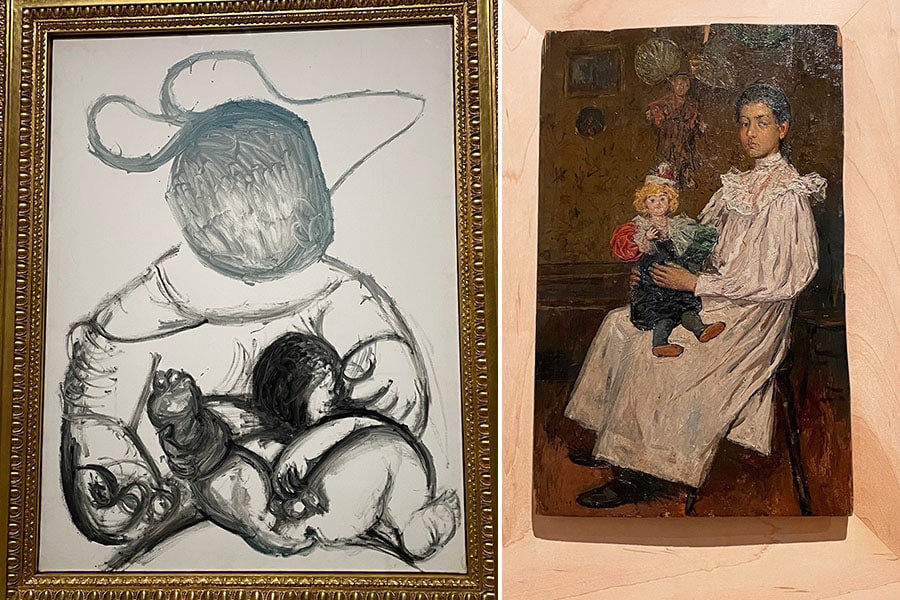 (L to R) Lola with a Doll and Maternity Mougins.
Image: Veidehi Gite
(L to R) Lola with a Doll and Maternity Mougins.
Image: Veidehi Gite
The figure on the far left displays facial features and attire reminiscent of Egyptian or southern Asian styles. The adjacent figures embody the Iberian style of Picasso's Spain, while the two on the right are characterised by African mask-like features. Picasso stated that the ethnic primitivism evoked in these masks inspired him to “liberate an utterly original artistic style of compelling, even savage force”, adding a shamanistic element to his work. Les Demoiselles d'Avignon also reflects Picasso's profound fear of disease, particularly syphilis, a significant concern in the pre-antibiotic era.
Whereas the third exhibit emphasises a harmony of opposites: Cubism and Classicism. The revolution of Cubism was the result of a self-conscious acceptance of art as a profoundly artificial construction. As Picasso said, “We all know that art is not truth. Art is a lie that makes us realise the truth.” This understanding enabled him to explore the artifice of all artistic practice by uniting the apparently opposing styles of Cubism and Classicism.
A short stroll down the city reveals street scenes and Eurasian collared doves, all of which influenced Picasso's artistic vision. I could easily envision a young Picasso sketching outdoors at a Plaza de la Constitución cafe, a scene he revisited in his art later. Further down, Calle Comedias unveils a building steeped in Picasso's childhood memories: The former San Rafael School. This is where a young Picasso was ushered in by his nanny, Carmen Mendoza.
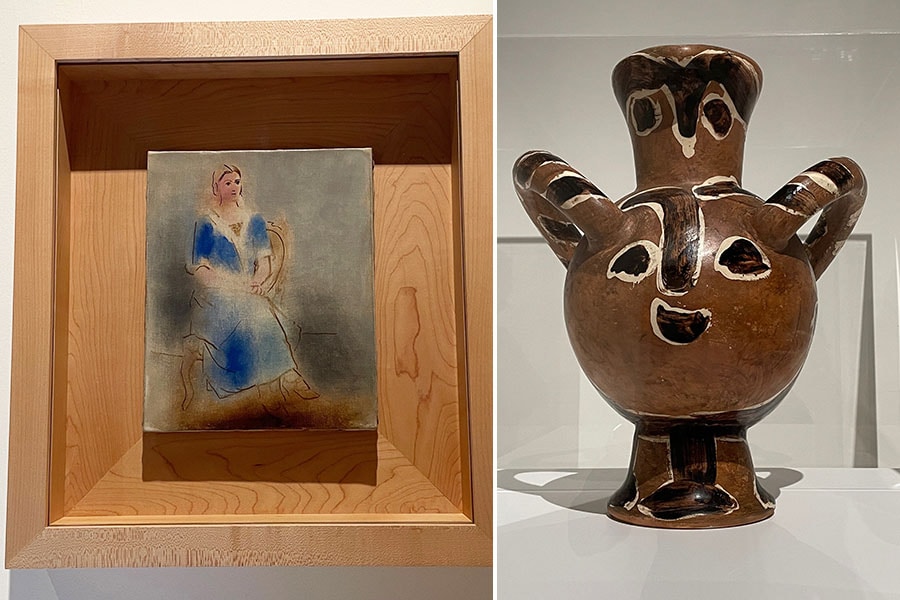 (L to R) Olga seated (Paris november 9 1923) bistre and oil on canvas and Owl with head of a Faun (Vallauris, autumn 1947) red earthenwater, thrown, painted with slips and oxides, partially glazed. Image: Veidehi Gite
(L to R) Olga seated (Paris november 9 1923) bistre and oil on canvas and Owl with head of a Faun (Vallauris, autumn 1947) red earthenwater, thrown, painted with slips and oxides, partially glazed. Image: Veidehi Gite
Years later, Picasso reminisced about his time at San Rafael. His biographers documented tales of a restless student, spending hours lost in doodles and gazing out the window. While the building itself isn't open to the public, it offers a fascinating reminder that even the most revolutionary artists were once just children, with their own unique blend of brilliance and mischief.
Picasso's father taught linear drawing and ornamentation at the School of Fine Arts, now the Ateneo de Málaga. It was here that Picasso first encountered classical plaster models, which he would later replicate during his studies in La Coruña and Barcelona. The school was frequented by artists like Muñoz Degrain, Martínez de la Vega, Bernardo Ferrándiz and Moreno Carbonero, who significantly influenced the young Picasso with their work from Málaga's late 19th-century Golden Age of painting. Witnessing their work firsthand profoundly impacted Picasso's development as an artist. Today, the building houses an exhibition space dedicated to the plastic arts.
Located just a stone's throw from the Plaza de la Merced, a hidden gem in the heart of Malaga, the Santiago Church holds a special significance for Picasso and his family. This historic church, built atop a former mosque, is the oldest in Malaga, dating back to 1490. The original Mudéjar-style façade and tower remain partially intact. Inside, the Gothic-Spanish Muslim architecture features three naves, originally just one, showcasing a cultural blend that may have inspired Picasso to depict characters from diverse ethnicities in his paintings. However, for the Picassos, the church held a deeper meaning. It was here in 1820 that Picasso's paternal grandparents exchanged vows, followed by his parents in 1880. Additionally, his sisters, Dolores and Concepción, were baptised at the Santiago Church font, cementing the church's significance in the family’s history.
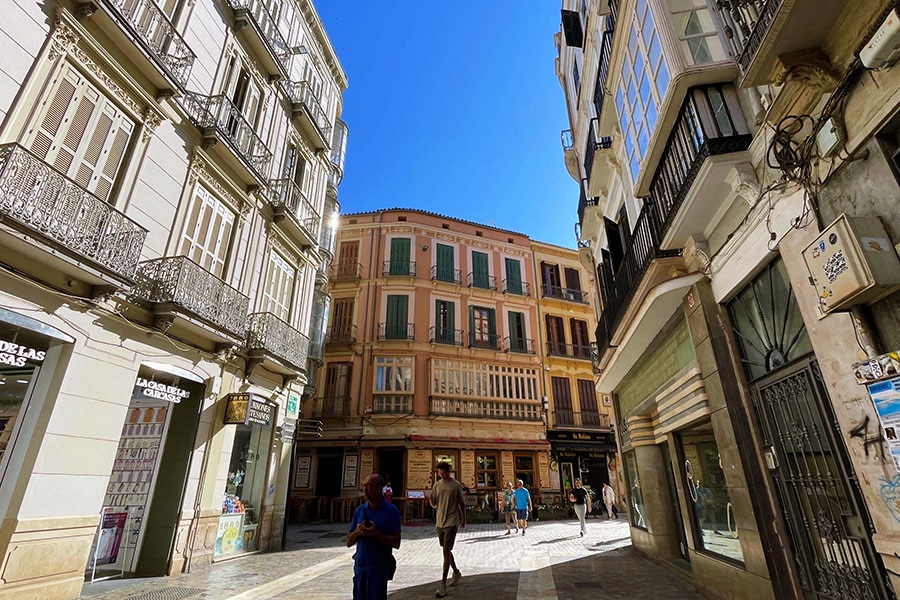 The Picasso Trail in Málaga, traces the artist's footsteps through his childhood haunts, influential landmarks, and the vibrant city that shaped his early years. Image: Veidehi Gite
The Picasso Trail in Málaga, traces the artist's footsteps through his childhood haunts, influential landmarks, and the vibrant city that shaped his early years. Image: Veidehi Gite
The oldest pharmacy in Málaga, situated at the corner of Calle Granada and Plaza de la Merced, remains operational today as the Bustamante pharmacy. This historic site served as a frequent gathering place for Pablo Picasso's father and his friends. Yet another important historic building in the heart of Málaga is the building that has housed the city council since 1869, and where Picasso’s father worked as a curator from 1879, overseeing the paintings displayed by the town hall. The young Picasso spent time here, exploring his father's workshop during his breaks from school.
The building, the San Juan de Dios Seminary, the Augustinian Fathers' Convent, and later the University of Málaga's Faculty of Philosophy and Letters, is now undergoing a transformation to become the Provincial Library of Málaga.
Picasso honed his skills at the School of Fine Arts under his father's tutelage until the age of 9 and wasn’t exactly thrilled when his family relocated to the Galician northwestern tip of Spain in 1891. No more sunshine, no more bulls, just a constant drizzle and a longing for his beloved Málaga. As a child, Picasso frequently attended bullfights with his father at Plaza de Toros, also known as La Malagueta. These early experiences were another profound influence on his artistic exploration of bullfighting themes, a passion that persisted through his career and notably surfaced in his masterpiece, Guernica (1937), which features the emblematic wounded horse.
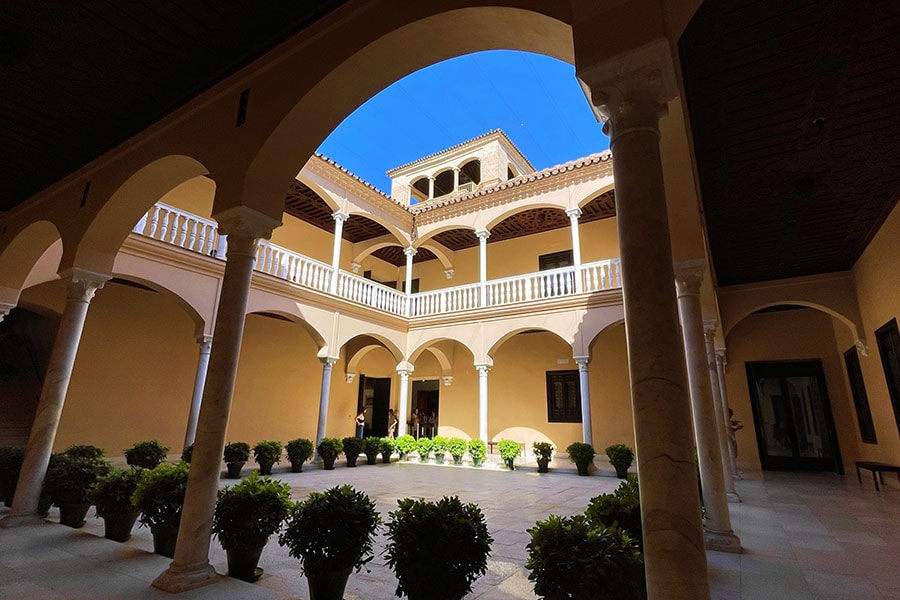 In 1997, the Regional Government of Andalusia purchased Buenavista Palace to house the museum, and Christine and Bernard Ruiz-Picasso (the artist’s grandson) donated 233 works to Fundación Museo Picasso. Image: Veidehi Gite
In 1997, the Regional Government of Andalusia purchased Buenavista Palace to house the museum, and Christine and Bernard Ruiz-Picasso (the artist’s grandson) donated 233 works to Fundación Museo Picasso. Image: Veidehi Gite
The influence is also seen in his early works. In 1889, just two years before relocating to La Coruña and subsequently to Barcelona with his family in 1895, at the age of 8 Picasso created his first painting, El Picador, depicting a bullfighter in the arena. The inspiration for this piece stemmed from the La Malagueta bullring, constructed in 1874 near the Málaga harbour. But La Coruña, a city brimming with artists and intellectuals, too awakened the creative fire within Picasso and even led to his first exhibition, held not in a gallery, but in a furniture shop on Rúa Real.
A shadow hangs over Picasso's last visit to his hometown in 1900. Joined by his friend and fellow painter, Carlos Casagemas, their stay was marked by misfortune. Denied entry to Picasso's uncle's residence on the fashionable Alameda Principal due to their unconventional attire, the trip took a turn for the worse. Friction grew between the friends, exacerbated by Casagemas' deep depression stemming from a failed love affair. Little did they know that their time in Málaga together would be their last. Weeks later, Casagemas tragically took his own life. The impact of this devastating event was profound, serving as a key catalyst for the emergence of Picasso's Blue period. The sombre, melancholic mood that permeates these works can be directly linked to the emotional turmoil he experienced following Casagemas' suicide.
As exhibitions worldwide honour the 51st anniversary of Picasso' passing in 1973, Spain leads with a host of tributes, offering a chance to explore the locales that shaped his genius. Nestled between Plaza de la Merced and the cathedral, the Museo Picasso Málaga houses a comprehensive collection spanning Picasso's Blue and Rose periods, Surrealism, and Cubism. "The Museo Picasso Málaga is overseen by the Fundación Museo Picasso Málaga, with one of Picasso's grandsons now at the helm. Bernard, the son of Picasso's first son, Legado Paul, and Christine Ruiz-Picasso, the second wife of Paul, are instrumental figures in this endeavour. Together, they established Picasso's private foundation, which holds ownership of the collection, the museum's assets, and Buenavista Palace, the institution's headquarters," my guide Trinidad Blanco says.
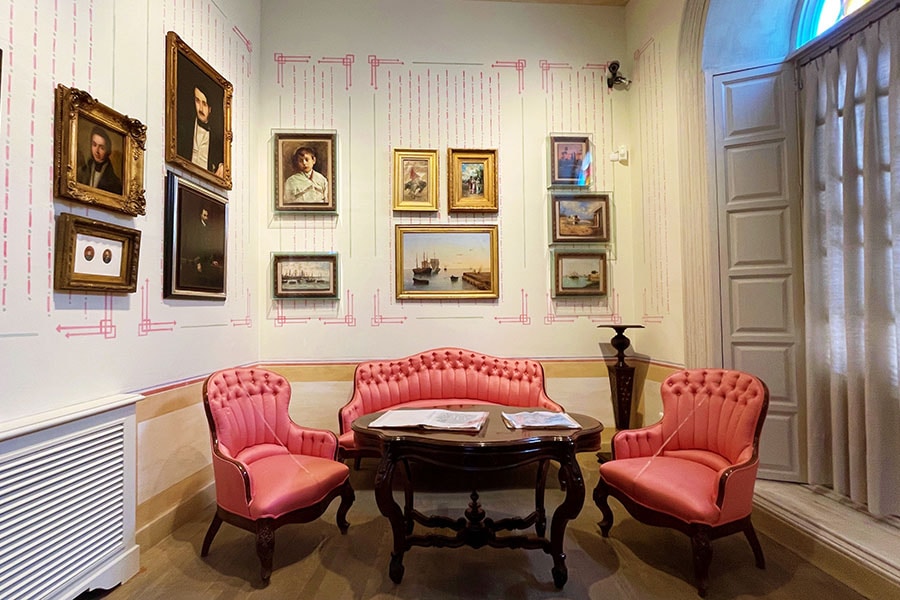 An exhibit at Museo Casa Natal de Picasso dedicated to bullrings and bullfighting, themes that inspired many of Picasso’s works. Image: Veidehi Gite
An exhibit at Museo Casa Natal de Picasso dedicated to bullrings and bullfighting, themes that inspired many of Picasso’s works. Image: Veidehi Gite
With paintings, sculptures, illustrations, and ceramics, it offers an unparalleled overview of the artist's evolution. Over the next three years, the Museo Picasso Málaga will host the exhibition ‘Pablo Picasso: Structures of Invention’. The 2024 programme includes a new installation of the museum’s collection, curated by José Lebrero Stals. Highlights feature a retrospective on Spanish painter María Blanchard, a key figure in the international modern movement; an exhibition dedicated to Marius de Zayas, the caricaturist, painter, and philanthropist; and a showcase of sketchbooks Picasso created in Royan, France, following the outbreak of World War II. In the aftermath of World War II, the world was a canvas of devastation. Yet, amidst the rubble, artistic genius found a way to bloom.
Until the spring of 2027, another exhibition, at the Palacio de Buenavista, will showcase approximately 150 works by Picasso under the title ‘Pablo Picasso: Structures of Invention. The Unity of a Life’s Work’. The exhibition will display paintings, sculptures, drawings, ceramics, and graphic works, offering a fresh context that uncovers new connections among Picasso’s creations and challenges conventional classifications. This initiative also highlights the significance of women artists' work. It offers a chronological survey of the career of painter María Blanchard, the first woman in Spain to embrace Cubism and experiment with fragmentation and multiple viewpoints in her compositions.
Not far from the museum lies La Garoupe beach, a cove on the Cap d'Antibes where Picasso would often sketch. While sunbathers and swimmers still flock to this idyllic spot, a new perspective is offered for curious travellers. The beach now boasts a lovely promenade winding along the sea, inviting you to retrace Picasso's artistic footsteps and ponder the complexities of his personal life.

















